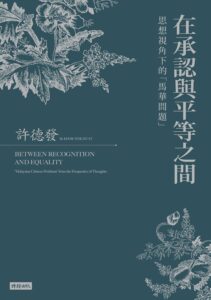
Khor Teik Huat 許德發
Taipei: China Times Publishing Co. (臺北:時報文化出版企業股份有限公司), 2022.
Reviewed by Lee Chee Yong (Ph.D. candidate of Hong Kong University of Science and Technology, HYI Visiting Fellow)
Malaysia, a multiracial and multicultural nation, gained independence from the British in 1957 as the Federation of Malaya. In 1963, the Federation merged with Sabah, Sarawak, and Singapore to form Malaysia. Following Singapore’s expulsion in 1965, Malaysia has maintained its current composition, with East Malaysia on Borneo and West Malaysia on the Malay Peninsula. Throughout its journey to independence and nation-building, Malaysia has been emphasizing collaboration and harmony within its diverse society. However, underlying tensions between different groups persist. The most severe manifestation of this was the Sino-Malay racial upheaval on May 13, 1969. This pivotal event led to the implementation of the New Economic Policy and the restructuring of the political system, advancing the ideology of Ketuanan Melayu or Malay supremacy. Since then, narratives of race, particularly the divide between Malay and Chinese communities, have been consistently politicized. The Malays often accuse the Chinese of undermining their economic dominance, while the Chinese feel marginalized and mistreated in various aspects.
Professor Khor Teik Huat’s Between Recognition and Equality: “Malaysian Chinese Problems” from the Perspective of Thoughts examines these tensions. The monograph draws upon a diverse range of scholars such as Roland N. Stromberg, John Rawls, Jürgen Habermas, Charles Taylor, Lin Yu-sheng, Hsiau A-chin, James Tully, John Gray, Axel Honneth, Will Kymlicka, and others. It addresses several key questions: What are the “Chinese problems” perceived by other races, especially the dominant Malay community? How have authorities and mass media shaped and disseminated these “Chinese problems” before and after Malaysia’s independence? Why do the “Chinese problems” come across as traumatic and political to Malaysian society? Khor demonstrates a profound concern, especially through the lens of political philosophy, intellectual history, narratives of race and ethnicity, with the anticipation that the questions raised will help us reexamine how we understand the identity crisis of Malaysian Chinese. Simultaneously, he hopes this clarification and reconciliation can foster mutual understanding among racial groups.
Comparative reading is one of Khor’s crucial methodologies for exploring the narrative gap. For example, he meticulously compares the Report of the Federation of Malaya Constitutional Commission with the Constitutional Proposals Federation of Malaya (White Paper), the latter of which became the primary document for formulating the constitution of Malaysia. Khor highlights the changes in content between these two reports and argues that Malay supremacy has been ingrained since the publication of the White Paper, forming an inevitable part of the negotiation for the Chinese and other races to gain recognition as Malay(si)an citizens. The Malays claim the status of Bumiputera, the autochthonous people in Malaya, underlining their in situ status as Nusantara inhabitants. By contrast, the rest, including the Chinese, are still often viewed by ultra-Malay politicians as pendatang, the immigrants, which perpetuates the racial divide.
Although the National Operations Council, an ad hoc administrative body, published The May 13 Tragedy: A Report, the official narrative remains vague and lacks comprehensive details. Khor delves into a comparison of news coverage during the incident, focusing primarily on the Chinese daily newspaper Nanyang Siang Pau南洋商報 and the Malay daily newspaper Berita Harian. While Nanyang Siang Pau took the bigger picture (「顧全大局」) into account by urging the reader to maintain calm and follow governmental instructions, Berita Harian shifted the blame toward the Communist Party of Malaya, triads, and gangsters—groups with a substantial Chinese presence. Despite differing responses to the tragedy, Khor notes that newspapers of both languages omitted crucial details such as the victims’ gender and races, their families’ emotions and reactions, and the troublemakers under suspicion. Khor’s investigation also reveals that two international news magazines, Time (Vol. 93 No. 21) and Newsweek (Vol. 73, Iss. 21), were prohibited in Malaysia unless they agreed to censor content that would disrupt social order. It might thus be valuable for us to further explore the perceptions of this tragedy in a global context, which will illuminate the challenges and significance of nation-building worldwide.
As Khor posits, the fundamental distinction lies in the disparate interpretations and expectations of fairness between the Chinese and Malay communities. The Chinese consistently advocate for equality (kesamarataan, 平等), emphasizing that everyone should be treated fairly. Conversely, the Malays often emphasize equity (kesaksamaan, 公正), highlighting the belief that individuals should receive the necessary resources to thrive. In his monograph, Khor adopts a somewhat pessimistic stance, suggesting that the racial divide will probably persist due to the inherent incompatibility of these differing perspectives. For communities to establish a pluralistic society imbued with a sense of communitarianism, there must be, he suggests, a willingness to engage in reciprocal understanding and empathy. This mutual exchange could pave the way to developing a nation characterized by multicultural citizenship.
In his monograph, Khor argues that Western theories, particularly postcolonialism, fall short of addressing the complexities of Malaysia’s post-independence era. Postcolonialism primarily critiques the colonizer, neglecting the issue of Malay supremacy. To deepen this discussion, we can explore how the prefix “post-” does not merely signify a temporal shift following the colonizer’s departure. Instead, it highlights the persistent legacies of colonialism. The racial issues examined in the monograph can be understood within the broader context of British colonization in Malaya, as the British established the framework that legitimized these dynamics.[1] This perspective not only avoids the impression of pitting the Chinese against the Malays but also contextualizes the “Chinese problems” as a form of ongoing resistance to the enduring impacts of British colonial rule.
[1] I would like to thank Ngoi Hui Chien for discussing this issue with me.
